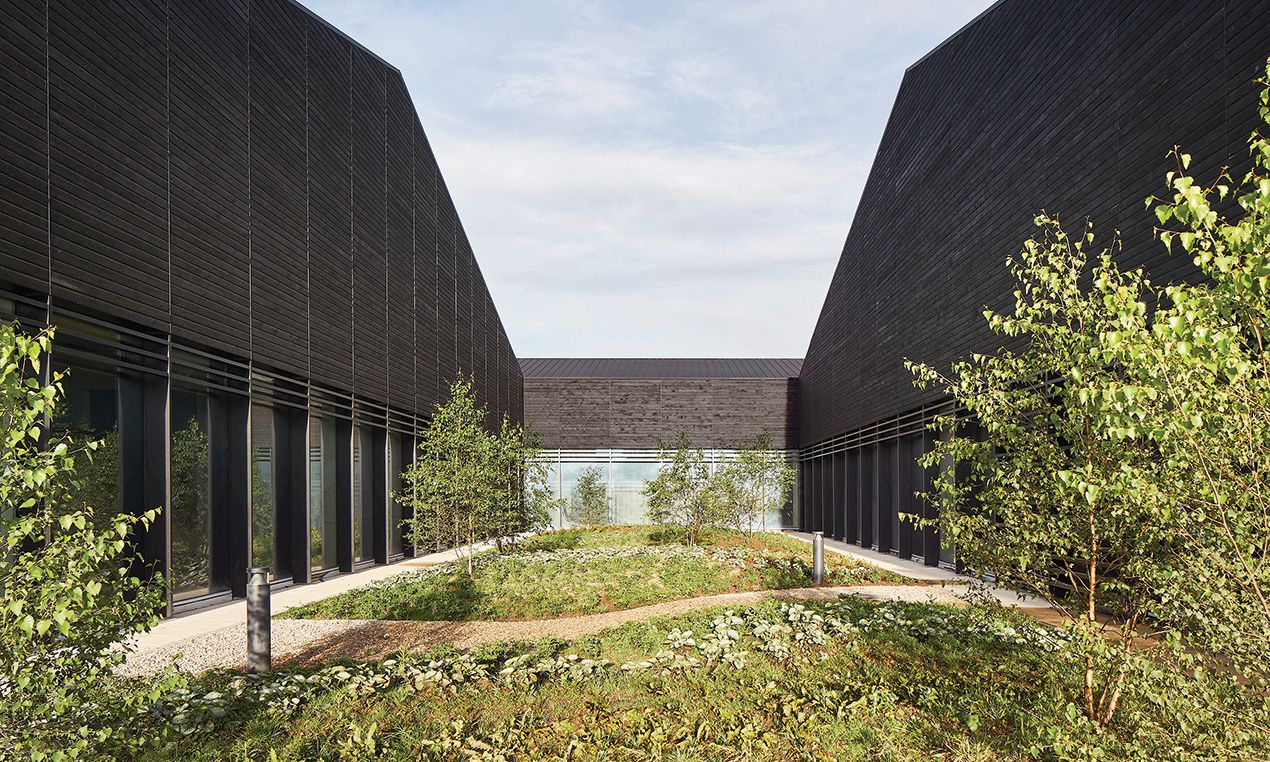The 15,628 sq. m facility, designed by the British practice John McAslan + Partners, is located 44 miles west of London and run in partnership with the University of Reading © Hufton+Crow
The British Museum is opening a new £64m storage and research facility in Berkshire on 7 June, designed to house around 1.3 million objects and to serve both scholars and, starting in the autumn, the general public.
Located 44 miles west of London, the new facility is designed by the UK practice John McAslan + Partners and will be run in partnership with the University of Reading. It is part of the first phase of the museum’s “masterplan”, which it describes as “one of the most significant cultural redevelopment projects ever undertaken”.
The new facility will increase public accessibility to some of the nation’s “most important historical objects” including ancient sculptures, mosaics and historic casts, the museum says. “It offers a radically different approach to museum storage by also facilitating research and study by academics and members of the public alike,” a British Museum statement says.
The opening comes at a time when the British Museum could use some good news, after a recent thefts scandal in which as many 2,000 objects are thought to have been removed from the collection.In March, the museum launched legal proceedings against one of its former curators, Peter Higgs.
Higgs was sacked last year following revelations that a large number of objects, some of which were not catalogued, had been damaged or gone missing; the museum subsequently sued him for the return of any remaining artefacts in his possession. His family says he denies all wrongdoing.
A British Museum spokesman says that every item at the new facility, known as BM_ARC, “has a digital record created in the museum’s catalogue”.
The objects housed at BM_ARC range from nails from the Sutton Hoo ship burial (an Anglo-Saxon site dating from the early seventh century) to rare Peruvian fabrics and ancient fingerprints preserved on 5,000-year-old antler picks, the spokesman says. These were previously housed at Blythe House in west London, which the museum sold for £50m—revenue that contributed to the construction of BM_ ARC.
“More than 2,500 historic casts representing monuments, sculpture and inscriptions from around the world have been transported from Blythe House,” the spokesman says. “Approximately 22,000 textiles as well as around 2,000 pieces of associated textile equipment will be stored at BM_ARC until suitable storage is available at Bloomsbury [the museum site in London]. The collection dates from 5,000 CE to the present day and spans most of the museum’s curatorial departments.”
BM_ARC’s 15,628 sq. m site will also provide the physical room for artefacts—which might be shown alone in the Bloomsbury site due to space constraints—to be displayed together in “assemblages”, providing greater context about their historic purpose and origin.
“I very much look forward to seeing it,” says Charles Saumarez Smith, the former director of the National Gallery in London. “It will be interesting to compare with V&A East in terms of levels of interpretation and public access.” The Victoria and Albert Museum’s future venue on the former Olympic site in Stratford will include open-access storage.
Currently around 80,000 artefacts are displayed at the British Museum in London. This amounts to around 1% of the institution’s 8 million-strong collection of objects, which were stored in archives located at the museum’s Bloomsbury site.
The complete masterplan, which will be overseen from this summer by the British Museum’s new director, Nicholas Cullinan, is likely to end up costing many hundreds of millions of pounds, possibly more than a billion, and could take decades. In a controversial move, the oil and gas company BP is to give £50m to the museum over the next decade to help fund the redevelopment.
The plan also involves a major overhaul of the main Bloomsbury site, with a third of the museum’s galleries set to be refurbished. Last month, the museum announced a competition to find an architectural practice that
can transform around 7,500 sq. m of gallery space.
The space in question encompasses the “Western Range”, which currently houses collections such as Ancient Egypt, Greece and Rome. Significant back-of-house areas are also set to be redesigned under the revamp.
There will also be a new museum Energy Centre, which will phase out the use of fossil fuels and replace them with low-carbon technologies. This should save 1,700 tonnes a year of carbon dioxide, making the institution more sustainable. The project will be partly funded with government support.
Asked if the new building in Berkshire meets environmental standards, the British Museum spokesman says that “BM_ARC is an all-electric building with a highly thermally energy efficient building enclosure … Other ecological measures at BM_ARC include nesting boxes, amphibian ladders in gulleys, badger gates, bat highways, and in the longer term, contribution to the maintenance of St John’s Copse, which is an area of ancient woodland” near the site.

